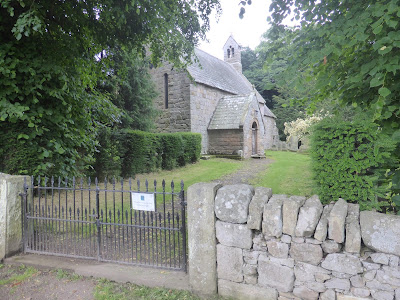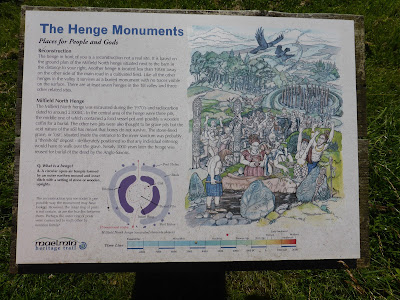Limestone crag and a hill fort over look Old Bewick Church.
(See part 1 here)
On the first day of our Northumbrian holiday we visited Old Bewick Church (See also here). It is situated in a copse of trees beside a small stream and in the shadow of the impressive limestone rise that once hosted Old Bewick Hill Fort. (See above). Although built in the 11th century the church, with its narrow windows, looked very Saxon in style to my eye. We visited on a Sunday but there were no services running on that particular day.
Inside the church there are copious notes to read. In one of these notes a regular visitor claimed that those who knew the church well get to know that feeling of it being a "thin place"; that's spiritual jargon for a portal in space-time where the divine presence is easily detected. I myself seldom or never pick up on these mystical moods, feelings, atmospheres, presences, or what have you that people say are associated with a location. However, it was easy to see why this site has a reputation for holy tranquility and peace. Its gently trickling stream and its insulating wall of trees provide the intimate atmosphere of a venue cut off from the surrounding world. It's a site for turning in on yourself with holy introspection and contemplation leading, perhaps, to an intuitive revelation of the divine (Usually referred to as "encounters" nowadays). It was no surprise, therefore, that just outside the gate of the church yard is poustinia, a small cell where one can retreat into the presence of God. This particular poustinia took the form of a thermally insulated garden shed. The insulation would also serve to deaden sounds, even the sounds of the birds in trees. So an already quiet environment becomes even quieter, perhaps helping to ensure that God's still small voice wouldn't be missed.
Inside the church there are copious notes to read. In one of these notes a regular visitor claimed that those who knew the church well get to know that feeling of it being a "thin place"; that's spiritual jargon for a portal in space-time where the divine presence is easily detected. I myself seldom or never pick up on these mystical moods, feelings, atmospheres, presences, or what have you that people say are associated with a location. However, it was easy to see why this site has a reputation for holy tranquility and peace. Its gently trickling stream and its insulating wall of trees provide the intimate atmosphere of a venue cut off from the surrounding world. It's a site for turning in on yourself with holy introspection and contemplation leading, perhaps, to an intuitive revelation of the divine (Usually referred to as "encounters" nowadays). It was no surprise, therefore, that just outside the gate of the church yard is poustinia, a small cell where one can retreat into the presence of God. This particular poustinia took the form of a thermally insulated garden shed. The insulation would also serve to deaden sounds, even the sounds of the birds in trees. So an already quiet environment becomes even quieter, perhaps helping to ensure that God's still small voice wouldn't be missed.
Old Bewick Church
On the following Wednesday we visited Duddo Stone Circle (See also here and here). The environs here couldn't be more different from Old Bewick Church. On its gentle treeless rise the circle provides good views of the surrounding scenery; most noticeable were the high barren igneous hills of the Cheviots to west. The stones are deeply fissured with vertical channels which, it is thought, are due to the erosive effects of rain water rivulets channeling away the soft sandstone. Two of the three websites I have just linked to date the circle as Neolithic and one Bronze age; If the former date is right then the monument is well over 4000 years old.
Duddo stone circle with the Cheviot hills in the background.
This website says of the circle:
Occasionally other people are about, taking photos, absorbing the setting, studying the stones or taking in the views across to the Cheviots and the Scottish Border. You may, though, find yourself completely alone in this ancient place, and feel a sense of peace and sanctuary that’s hard to find in the modern world.
Hence, the theme of sanctuary and separation which started for us at Old Bewick church continued. It was towards the end of the day and so we had the lonely circle to ourselves. To me the sense of long abandonment and dereliction were my strongest impressions. Moreover, that these silent stones reveal so little of their long since forgotten purpose heightens the general air of mystery which pervades this place. As this web site says:
Britain is littered with the remains of past lives, civilisations and cultures, many of which remain a source of mystery and conjecture. We may never know the exact reasons why these circles, standing stones, henges, hill-figures and monuments were erected or the peoples and belief systems that led them to complete some of these sometimes massive structures such as Silbury Hill and Stonehenge.
The
inscrutable mystery of meaning and purpose hangs like an impenetrable mist over
all megalithic monuments, almost to the point of frustration; why can't they
reveal just a little more of what they were about? But no, they give away nothing by way of history and
very little by way of archaeology. What compounds the problem is that their
configuration is so different from the familiar linear Biblico-classical temple where history tells us that the inner sanctum, the holy of holies, was a space
set aside for the divine presence, symbolized in most cases by an effigy. In fact there was an echo of this configuration in the layout of medieval churches. So can we conclude that the centre of these circles was a kind of holy of holies?
One thing, however. does seem fairly probable: These stone circles weren't the introverted sites of contemporary Christianity, a Christianity which seeks internal and intimate revelation of God in an otherwise spiritually barren material world evacuated of sacred meaning by a seemingly heartless mechanical paradigm. In contrast to the spiritual introversion encouraged at Old Bewick the location and configurations of these monolithic structures were deliberately designed to connect with their surroundings; for they show the kind alignments to the heavens important to an agricultural society and also, some have speculated, alignments with the surrounding landscape. In which case these stone circles are focal points which encourage us to look out as well as in. To these ancient peoples the cosmos was a temple full of spiritual significance. Their imaginations and myths made sense of an environment which, in comparison with modern times, they really hadn't even started to get to grips with intellectually. In the stone circles we are looking at a reification of a mythical spiritual vision, May be there are parallels with the Ptolemaic cosmos of the Middle Ages.
We guess that these sites had sacred purposes, but actually this is an interpolation because we find it difficult to imagine that to ancient communities they could be anything else. That morning we had visited a henge reconstruction at Milfield (see below) and this underlined the point: Unless one is enamored of the silly idea that these are UFO landing strips then there are few options left other than to think of them as "ritual" venues; that is, our imagination populates them with priests and worshipers engaged in formal communion with spiritual forces and beings. But the modern scientific quasi-autonomous mechanical paradigm, which has for many had the effect of exorcising any sacred import, had no parallel among these people. and you can bet that, unlike us, they didn't make a distinction between the secular and the sacred. That may explain why their religion was so intertwined with the cosmos as a whole; as I have already implied, the nearest Western equivalent of that is probably the Ptolemaic universe of the Middle Ages.One thing, however. does seem fairly probable: These stone circles weren't the introverted sites of contemporary Christianity, a Christianity which seeks internal and intimate revelation of God in an otherwise spiritually barren material world evacuated of sacred meaning by a seemingly heartless mechanical paradigm. In contrast to the spiritual introversion encouraged at Old Bewick the location and configurations of these monolithic structures were deliberately designed to connect with their surroundings; for they show the kind alignments to the heavens important to an agricultural society and also, some have speculated, alignments with the surrounding landscape. In which case these stone circles are focal points which encourage us to look out as well as in. To these ancient peoples the cosmos was a temple full of spiritual significance. Their imaginations and myths made sense of an environment which, in comparison with modern times, they really hadn't even started to get to grips with intellectually. In the stone circles we are looking at a reification of a mythical spiritual vision, May be there are parallels with the Ptolemaic cosmos of the Middle Ages.
Henge reconstruction at Milfield
In contrast to these henge communities the dynamic behind most of the constructions we see today is largely down to material acquisitiveness: Investments are made in order to further increase investment in a regenerative feedback cycle whose output is material wealth for its own sake. But these temple monuments were sinks of surplus labour; apart from social cohesion the material benefits of these works would to us seem questionable as they never payed back on the labour investment. Therefore with apparently little material reward for the rank and file it is very likely that henge societies came down heavily on heretics and dissenters; with such discipline, organisation and commitment evident in these structures I can't imagine that their corresponding societies were liberal minded and the innate human fear of the numinous was probably played for all it was worth; something we actually see today among fundamentalists.
The religious motive, when unleashed, is strong, although it can be irrational to the point of its own detriment - see for example the behaviour Daesh (i.e. so called "Islamic State"). As we saw in the last part material acquisitiveness is bound up with status seeking. But it seems that religious motive revolving round deep seated human yearnings for meaning, purpose and identification can override the motives behind wealth creation thus providing a data point of evidence which coheres with the narratives of theism. But either way human motivations, as we well know, can go so horribly wrong!
Visitor information board at Milfield henge reconstruction
The ancient Cheviot hills (in the background) dominate the country side for miles around and put human existence into perspective. This photo was taken in the church yard at Ford.
Ford church: I found this to be an intriguing and original portrayal of the crucifixion. The figures display a mixture of ambivalent emotions in a depiction which, by using a low-rise cross, conveys the tragic ordinariness and brutality of first century crucifixion. And yet the unusual otherworldly lighting effects which explain the awestruck reaction of the figures are executed without making the picture kitsch Who ever painted this scene understood the meaning of the cross; God introduces himself to humankind, but not in the way humankind is likely to expect.







No comments:
Post a Comment